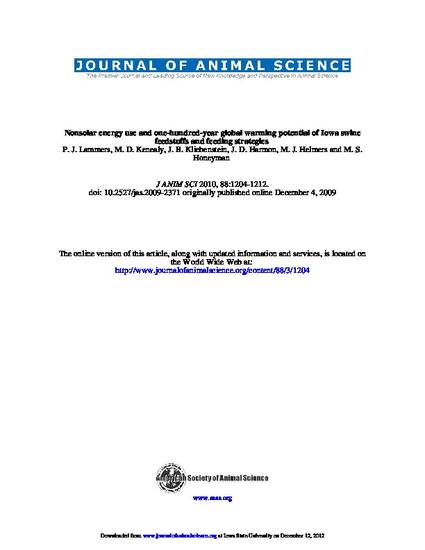
Demand for nonsolar energy and concern about the implications of fossil fuel combustion have encouraged examination of energy use associated with agriculture. The United States is a global leader in pig production, and the United States swine industry is centered in Iowa. Feed is the largest individual input in pig production, but the energy consumption of the Iowa swine feed production chain has yet to be critically examined. This analysis examines nonsolar energy use and resulting 100-yr global warming potential (GWP) associated with the swine feed production chain, beginning with cultivation of crops and concluding with diet formulation. The nonsolar energy use and accompanying 100-yr GWP associated with production of 13 common swine feed ingredients are estimated. Two diet formulation strategies are considered for 4 crop sequence × ingredient choice combinations to generate 8 crop sequence × diet formulation scenarios. The first formulation strategy (simple) does not include synthetic AA or phytase. The second strategy (complex) reduces CP content of the diet by using L-lysine to meet standardized ileal digestibility lysine requirements of pigs and includes the exogenous enzyme phytase. Regardless of crop sequence × diet formulation scenario, including the enzyme phytase is energetically favorable and reduces the potential excretion of P by reducing or removing inorganic P from the complete diet. Including L-lysine reduces the CP content of the diet and requires less nonsolar energy to deliver adequate standardized ileal digestible lysine than simply feeding soybean meal. Replacing soybean meal with full-fat soybeans is not energetically beneficial under Iowa conditions. Swine diets including dried distillers grains with solubles and crude glycerol require approximately 50% more nonsolar energy inputs than corn-soybean meal diets or corn-soybean meal diets including oats. This study provides essential information on cultivation, processing, and manufacture of swine feed ingredients in Iowa that can be coupled with other models to estimate the nonsolar energy use and 100-yr GWP of pig production.
Available at: http://works.bepress.com/jay_harmon/52/

This article is from Journal of Animal Science 88, no. 3 (March 2010): 1204–1212, doi: 10.2527/jas.2009-2371. Posted with permission.